Communication in HSC Report
VerifiedAdded on 2019/12/03
|14
|5537
|210
Report
AI Summary
This report comprehensively examines communication within the context of Health and Social Care (HSC). It delves into various communication theories, such as SOLER, the communication cycle, Tuckman's stages, humanistic learning theory, and social learning theory, applying them to practical scenarios within HSC settings. The report further explores essential communication skills like questioning, clarification, reflecting, empathy, summarizing, and active listening, emphasizing their importance in effective doctor-patient interactions. Methods for addressing inappropriate interpersonal communication, including staff training, need assessment, and reactive methods, are discussed. Strategies to support users with specific communication needs, such as assistive technology, translators, tactile signing, and leaflets, are also detailed. The influence of values and cultural factors on the communication process is analyzed, along with the impact of relevant legislation, charters, and codes of practice. The report also assesses the effectiveness of organizational systems and policies in promoting good communication practices and suggests ways to improve communication within HSC settings. Finally, it explores the assessment and use of ICT software packages to support HSC work, highlighting the benefits of ICT and the impact of legal considerations on its use. The report concludes by emphasizing the crucial role of effective communication in achieving desired targets and improving performance within HSC organizations.
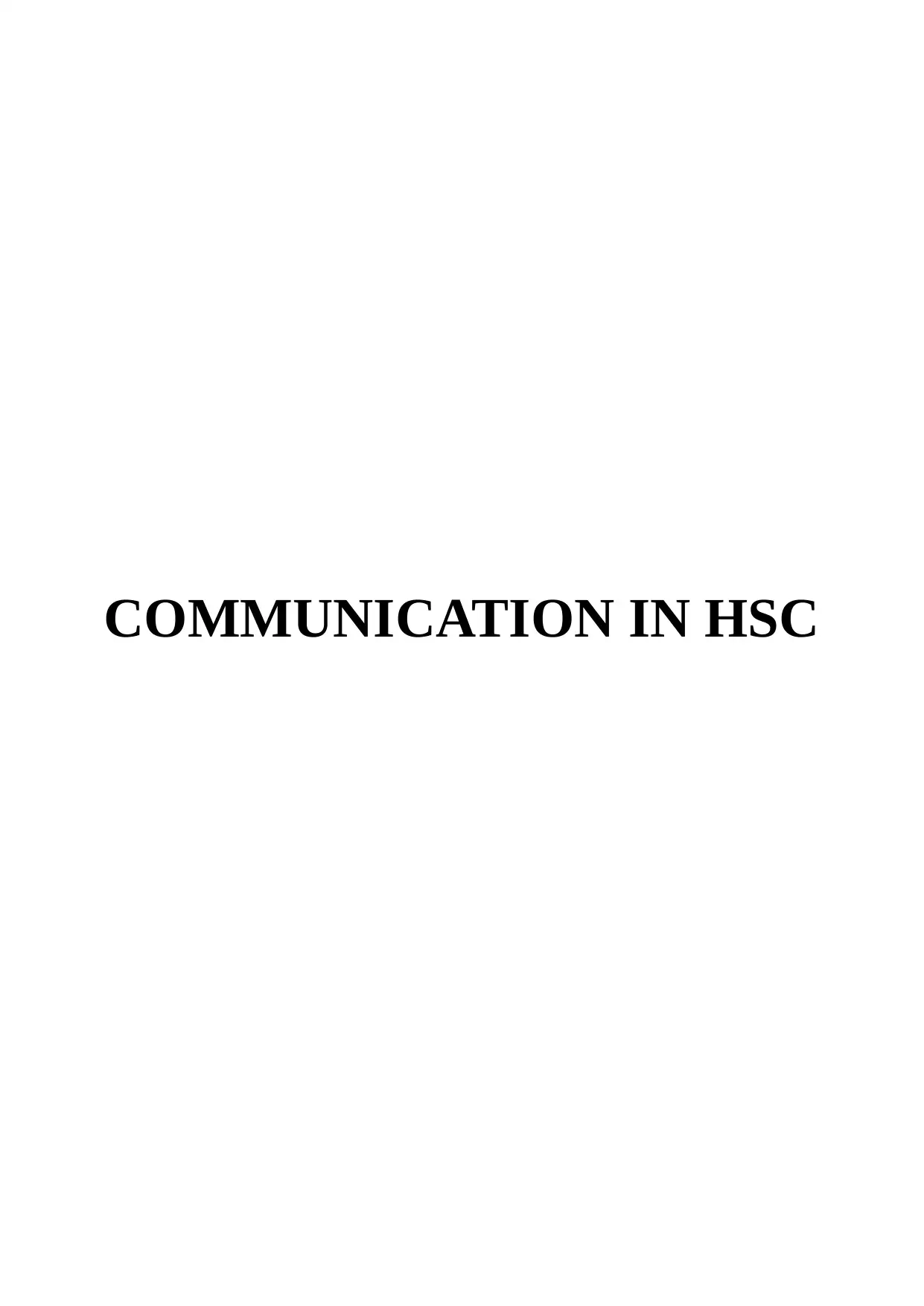
COMMUNICATION IN HSC
Paraphrase This Document
Need a fresh take? Get an instant paraphrase of this document with our AI Paraphraser

TABLE OF CONTENTS
INTRODUCTION ...............................................................................................................................3
TASK 1.................................................................................................................................................3
1.1 Theories of communication to health and social care contexts.................................................3
1.2 Use communication skills in a health and social care context...................................................4
1.3 Methods of dealing with inappropriate interpersonal communication between individuals...4
1.4 Use of strategies to support users with specific communication needs....................................5
TASK 2 ................................................................................................................................................6
2.1 Explain how the communication process is influenced by values and cultural factors.............6
2.2 Impact of legislation, charters and codes of practice on the communication process in HSC. .6
2.3 Effectiveness of organisational systems and policies in promoting good practice in
communication.................................................................................................................................7
2.4 Ways of improving the communication process in a health and social care setting.................7
TASK 3 ................................................................................................................................................8
3.1 Accessment and use of ICT software packages to support work in health and social care......8
3.2 Benefits of using ICT ................................................................................................................9
3.3 Impact of legal considerations in the use of ICT on health and social care...............................9
CONCLUSION..................................................................................................................................10
References...........................................................................................................................................11
INTRODUCTION ...............................................................................................................................3
TASK 1.................................................................................................................................................3
1.1 Theories of communication to health and social care contexts.................................................3
1.2 Use communication skills in a health and social care context...................................................4
1.3 Methods of dealing with inappropriate interpersonal communication between individuals...4
1.4 Use of strategies to support users with specific communication needs....................................5
TASK 2 ................................................................................................................................................6
2.1 Explain how the communication process is influenced by values and cultural factors.............6
2.2 Impact of legislation, charters and codes of practice on the communication process in HSC. .6
2.3 Effectiveness of organisational systems and policies in promoting good practice in
communication.................................................................................................................................7
2.4 Ways of improving the communication process in a health and social care setting.................7
TASK 3 ................................................................................................................................................8
3.1 Accessment and use of ICT software packages to support work in health and social care......8
3.2 Benefits of using ICT ................................................................................................................9
3.3 Impact of legal considerations in the use of ICT on health and social care...............................9
CONCLUSION..................................................................................................................................10
References...........................................................................................................................................11
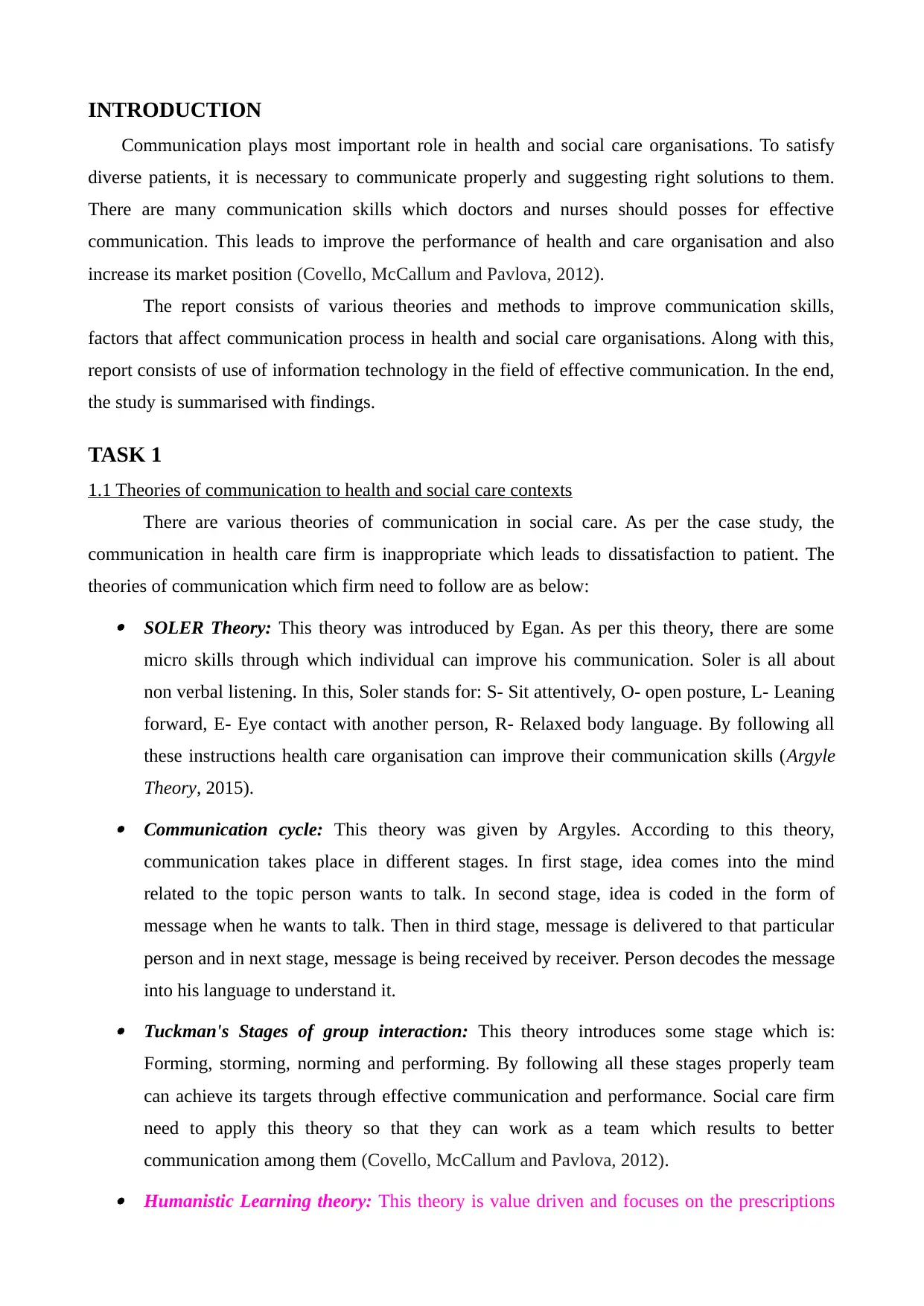
INTRODUCTION
Communication plays most important role in health and social care organisations. To satisfy
diverse patients, it is necessary to communicate properly and suggesting right solutions to them.
There are many communication skills which doctors and nurses should posses for effective
communication. This leads to improve the performance of health and care organisation and also
increase its market position (Covello, McCallum and Pavlova, 2012).
The report consists of various theories and methods to improve communication skills,
factors that affect communication process in health and social care organisations. Along with this,
report consists of use of information technology in the field of effective communication. In the end,
the study is summarised with findings.
TASK 1
1.1 Theories of communication to health and social care contexts
There are various theories of communication in social care. As per the case study, the
communication in health care firm is inappropriate which leads to dissatisfaction to patient. The
theories of communication which firm need to follow are as below:
SOLER Theory: This theory was introduced by Egan. As per this theory, there are some
micro skills through which individual can improve his communication. Soler is all about
non verbal listening. In this, Soler stands for: S- Sit attentively, O- open posture, L- Leaning
forward, E- Eye contact with another person, R- Relaxed body language. By following all
these instructions health care organisation can improve their communication skills (Argyle
Theory, 2015).
Communication cycle: This theory was given by Argyles. According to this theory,
communication takes place in different stages. In first stage, idea comes into the mind
related to the topic person wants to talk. In second stage, idea is coded in the form of
message when he wants to talk. Then in third stage, message is delivered to that particular
person and in next stage, message is being received by receiver. Person decodes the message
into his language to understand it.
Tuckman's Stages of group interaction: This theory introduces some stage which is:
Forming, storming, norming and performing. By following all these stages properly team
can achieve its targets through effective communication and performance. Social care firm
need to apply this theory so that they can work as a team which results to better
communication among them (Covello, McCallum and Pavlova, 2012).
Humanistic Learning theory: This theory is value driven and focuses on the prescriptions
Communication plays most important role in health and social care organisations. To satisfy
diverse patients, it is necessary to communicate properly and suggesting right solutions to them.
There are many communication skills which doctors and nurses should posses for effective
communication. This leads to improve the performance of health and care organisation and also
increase its market position (Covello, McCallum and Pavlova, 2012).
The report consists of various theories and methods to improve communication skills,
factors that affect communication process in health and social care organisations. Along with this,
report consists of use of information technology in the field of effective communication. In the end,
the study is summarised with findings.
TASK 1
1.1 Theories of communication to health and social care contexts
There are various theories of communication in social care. As per the case study, the
communication in health care firm is inappropriate which leads to dissatisfaction to patient. The
theories of communication which firm need to follow are as below:
SOLER Theory: This theory was introduced by Egan. As per this theory, there are some
micro skills through which individual can improve his communication. Soler is all about
non verbal listening. In this, Soler stands for: S- Sit attentively, O- open posture, L- Leaning
forward, E- Eye contact with another person, R- Relaxed body language. By following all
these instructions health care organisation can improve their communication skills (Argyle
Theory, 2015).
Communication cycle: This theory was given by Argyles. According to this theory,
communication takes place in different stages. In first stage, idea comes into the mind
related to the topic person wants to talk. In second stage, idea is coded in the form of
message when he wants to talk. Then in third stage, message is delivered to that particular
person and in next stage, message is being received by receiver. Person decodes the message
into his language to understand it.
Tuckman's Stages of group interaction: This theory introduces some stage which is:
Forming, storming, norming and performing. By following all these stages properly team
can achieve its targets through effective communication and performance. Social care firm
need to apply this theory so that they can work as a team which results to better
communication among them (Covello, McCallum and Pavlova, 2012).
Humanistic Learning theory: This theory is value driven and focuses on the prescriptions
⊘ This is a preview!⊘
Do you want full access?
Subscribe today to unlock all pages.

Trusted by 1+ million students worldwide

rather than description. By applying this theory in the working environment of health care
firm, team can be able to make social workers learn values, morale and ethics. By focusing
on the human freedom, dignity and potential health care organisation will be able to improve
the communication and cooperation between service users and workers.
Social Learning Theory: This theory helps in learning by using observation, modelling and
imitation. With the help of these methods, nurses and doctors can learn from each other so
that they can improve their communication and other related skills. This will help in
improving the relationship with service users.
1.2 Use communication skills in a health and social care context
Communication skills refer to the ability to transfer the information from one person to
another. For better communication among nurses, doctors and patients, it is important to have good
communication skills. They have to use the following skills for effective communication:
Questioning: By asking right question by doctor to patients at right situation can improve
the communication between them. Through this, doctors can get detailed information about
patient's problem which helps in finding right solution (Arnold and Boggs, 2015). It results
to appropriate medication and treatment.
Clarification: After gathering all the information from patient, doctor needs to clarify and
explain the reasons behind that problem. This clarification should be proper which does not
lead to any kind of confusion or misunderstanding.
Reflecting: Through this doctor needs to paraphrasing and restating his feelings and words.
This skill results in clarifying any confusion and let patient know that doctor is listening and
paying attention to his words. This requires accurate perception of doctor (Hughes and
Ferrett, 2012).
Empathy: This is a skill of watching situation as per doctor's perception. This leads to
increase social interaction between doctor and patient. It contain understanding yourself,
understanding doctor and nurses, and non verbal communication (Empathy, 2015).
Summarizing: This skill is for better communication and conflict resolution. It makes both
patient and doctor confident that whatever communication takes place between them is
100% clear and there is no confusion and misunderstanding (Communication and conflict,
2015).
Active Listening: At the time of talking, people generally do not listen or half listen to each
other which cause misunderstanding. In the given scenario, this method can help in proper
firm, team can be able to make social workers learn values, morale and ethics. By focusing
on the human freedom, dignity and potential health care organisation will be able to improve
the communication and cooperation between service users and workers.
Social Learning Theory: This theory helps in learning by using observation, modelling and
imitation. With the help of these methods, nurses and doctors can learn from each other so
that they can improve their communication and other related skills. This will help in
improving the relationship with service users.
1.2 Use communication skills in a health and social care context
Communication skills refer to the ability to transfer the information from one person to
another. For better communication among nurses, doctors and patients, it is important to have good
communication skills. They have to use the following skills for effective communication:
Questioning: By asking right question by doctor to patients at right situation can improve
the communication between them. Through this, doctors can get detailed information about
patient's problem which helps in finding right solution (Arnold and Boggs, 2015). It results
to appropriate medication and treatment.
Clarification: After gathering all the information from patient, doctor needs to clarify and
explain the reasons behind that problem. This clarification should be proper which does not
lead to any kind of confusion or misunderstanding.
Reflecting: Through this doctor needs to paraphrasing and restating his feelings and words.
This skill results in clarifying any confusion and let patient know that doctor is listening and
paying attention to his words. This requires accurate perception of doctor (Hughes and
Ferrett, 2012).
Empathy: This is a skill of watching situation as per doctor's perception. This leads to
increase social interaction between doctor and patient. It contain understanding yourself,
understanding doctor and nurses, and non verbal communication (Empathy, 2015).
Summarizing: This skill is for better communication and conflict resolution. It makes both
patient and doctor confident that whatever communication takes place between them is
100% clear and there is no confusion and misunderstanding (Communication and conflict,
2015).
Active Listening: At the time of talking, people generally do not listen or half listen to each
other which cause misunderstanding. In the given scenario, this method can help in proper
Paraphrase This Document
Need a fresh take? Get an instant paraphrase of this document with our AI Paraphraser
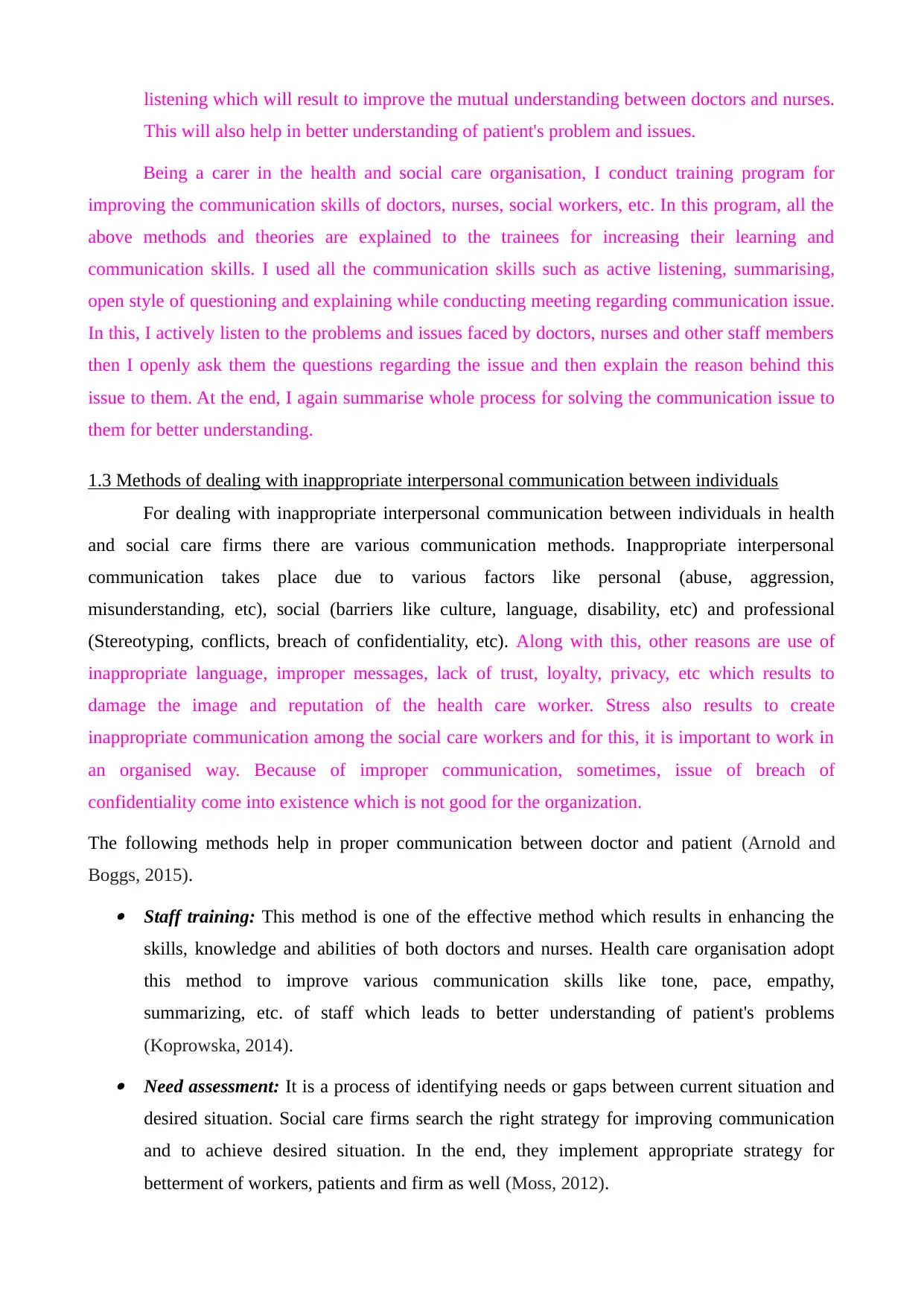
listening which will result to improve the mutual understanding between doctors and nurses.
This will also help in better understanding of patient's problem and issues.
Being a carer in the health and social care organisation, I conduct training program for
improving the communication skills of doctors, nurses, social workers, etc. In this program, all the
above methods and theories are explained to the trainees for increasing their learning and
communication skills. I used all the communication skills such as active listening, summarising,
open style of questioning and explaining while conducting meeting regarding communication issue.
In this, I actively listen to the problems and issues faced by doctors, nurses and other staff members
then I openly ask them the questions regarding the issue and then explain the reason behind this
issue to them. At the end, I again summarise whole process for solving the communication issue to
them for better understanding.
1.3 Methods of dealing with inappropriate interpersonal communication between individuals
For dealing with inappropriate interpersonal communication between individuals in health
and social care firms there are various communication methods. Inappropriate interpersonal
communication takes place due to various factors like personal (abuse, aggression,
misunderstanding, etc), social (barriers like culture, language, disability, etc) and professional
(Stereotyping, conflicts, breach of confidentiality, etc). Along with this, other reasons are use of
inappropriate language, improper messages, lack of trust, loyalty, privacy, etc which results to
damage the image and reputation of the health care worker. Stress also results to create
inappropriate communication among the social care workers and for this, it is important to work in
an organised way. Because of improper communication, sometimes, issue of breach of
confidentiality come into existence which is not good for the organization.
The following methods help in proper communication between doctor and patient (Arnold and
Boggs, 2015).
Staff training: This method is one of the effective method which results in enhancing the
skills, knowledge and abilities of both doctors and nurses. Health care organisation adopt
this method to improve various communication skills like tone, pace, empathy,
summarizing, etc. of staff which leads to better understanding of patient's problems
(Koprowska, 2014).
Need assessment: It is a process of identifying needs or gaps between current situation and
desired situation. Social care firms search the right strategy for improving communication
and to achieve desired situation. In the end, they implement appropriate strategy for
betterment of workers, patients and firm as well (Moss, 2012).
This will also help in better understanding of patient's problem and issues.
Being a carer in the health and social care organisation, I conduct training program for
improving the communication skills of doctors, nurses, social workers, etc. In this program, all the
above methods and theories are explained to the trainees for increasing their learning and
communication skills. I used all the communication skills such as active listening, summarising,
open style of questioning and explaining while conducting meeting regarding communication issue.
In this, I actively listen to the problems and issues faced by doctors, nurses and other staff members
then I openly ask them the questions regarding the issue and then explain the reason behind this
issue to them. At the end, I again summarise whole process for solving the communication issue to
them for better understanding.
1.3 Methods of dealing with inappropriate interpersonal communication between individuals
For dealing with inappropriate interpersonal communication between individuals in health
and social care firms there are various communication methods. Inappropriate interpersonal
communication takes place due to various factors like personal (abuse, aggression,
misunderstanding, etc), social (barriers like culture, language, disability, etc) and professional
(Stereotyping, conflicts, breach of confidentiality, etc). Along with this, other reasons are use of
inappropriate language, improper messages, lack of trust, loyalty, privacy, etc which results to
damage the image and reputation of the health care worker. Stress also results to create
inappropriate communication among the social care workers and for this, it is important to work in
an organised way. Because of improper communication, sometimes, issue of breach of
confidentiality come into existence which is not good for the organization.
The following methods help in proper communication between doctor and patient (Arnold and
Boggs, 2015).
Staff training: This method is one of the effective method which results in enhancing the
skills, knowledge and abilities of both doctors and nurses. Health care organisation adopt
this method to improve various communication skills like tone, pace, empathy,
summarizing, etc. of staff which leads to better understanding of patient's problems
(Koprowska, 2014).
Need assessment: It is a process of identifying needs or gaps between current situation and
desired situation. Social care firms search the right strategy for improving communication
and to achieve desired situation. In the end, they implement appropriate strategy for
betterment of workers, patients and firm as well (Moss, 2012).

Reactive method: It is a slow process in which top management orders to take appropriate
action for changing environment of firm. They form such environment which motivates
doctors and nurses to improve their body language, feel confident and self assured. Such
environment also makes patients feel comfortable and satisfied. This method also helps in
diffusing aggression of workers (Proactive vs reactive: how to prevent problems instead of
fixing them faster, 2015).
In the given case study, the communication between doctor and patient is not appropriate
because doctor does not have proper communication skills. There was lack of active listening,
proper questioning, explaining and summarising. Due to this, service user feels like mistreated
which create the feeling of dissatisfaction.
1.4 Use of strategies to support users with specific communication needs
To satisfy needs and demands of users is health and social care firm's prime responsibility.
The factors that plays important role in satisfying users is effective communication. Firm can use
various strategies for fulfilling communication needs of users which are explained below:
Assistive Technology: This technology is umbrella term which includes those devices which
helps disable people in effective communication. It consists of process for selecting, locating
and using those adaptive and rehabilitative devices (Kreuter and et.al., 2013). These devices
are for those patients who cannot see or hear properly. For visual impairments there are
many tools and techniques like screen readers, Braille, desktop video magnifier, Braille
embossers, and screen magnification software. The patients who are deaf or cannot hear
properly it become difficult to communicate and perceive information for them. To solve
these problems, there are various tools and techniques which can help them in proper
hearing and communicating. These devices are hearing aids, assistive listening devices and
amplified telephone equipments (Street, Gold and Manning, 2013).
Translators: Hiring translators helps in proper exchange of ideas, thoughts and views.
Patients belong from different background due to which they have different culture and
different languages. To communicate with them properly, health and social care
organisations can hire translators who work as mediator between staff and patient. He
encodes and decodes the messages for better communication between them. They translate
messages in the language of patient and help them in communication. They also try to
building good relations among the staff members and patients. This relation leads to trust
and loyalty which satisfy patients (Gilman, 2013).
Tactile Signing: Healthcare firm can use this technique for the people having both sight and
action for changing environment of firm. They form such environment which motivates
doctors and nurses to improve their body language, feel confident and self assured. Such
environment also makes patients feel comfortable and satisfied. This method also helps in
diffusing aggression of workers (Proactive vs reactive: how to prevent problems instead of
fixing them faster, 2015).
In the given case study, the communication between doctor and patient is not appropriate
because doctor does not have proper communication skills. There was lack of active listening,
proper questioning, explaining and summarising. Due to this, service user feels like mistreated
which create the feeling of dissatisfaction.
1.4 Use of strategies to support users with specific communication needs
To satisfy needs and demands of users is health and social care firm's prime responsibility.
The factors that plays important role in satisfying users is effective communication. Firm can use
various strategies for fulfilling communication needs of users which are explained below:
Assistive Technology: This technology is umbrella term which includes those devices which
helps disable people in effective communication. It consists of process for selecting, locating
and using those adaptive and rehabilitative devices (Kreuter and et.al., 2013). These devices
are for those patients who cannot see or hear properly. For visual impairments there are
many tools and techniques like screen readers, Braille, desktop video magnifier, Braille
embossers, and screen magnification software. The patients who are deaf or cannot hear
properly it become difficult to communicate and perceive information for them. To solve
these problems, there are various tools and techniques which can help them in proper
hearing and communicating. These devices are hearing aids, assistive listening devices and
amplified telephone equipments (Street, Gold and Manning, 2013).
Translators: Hiring translators helps in proper exchange of ideas, thoughts and views.
Patients belong from different background due to which they have different culture and
different languages. To communicate with them properly, health and social care
organisations can hire translators who work as mediator between staff and patient. He
encodes and decodes the messages for better communication between them. They translate
messages in the language of patient and help them in communication. They also try to
building good relations among the staff members and patients. This relation leads to trust
and loyalty which satisfy patients (Gilman, 2013).
Tactile Signing: Healthcare firm can use this technique for the people having both sight and
⊘ This is a preview!⊘
Do you want full access?
Subscribe today to unlock all pages.

Trusted by 1+ million students worldwide
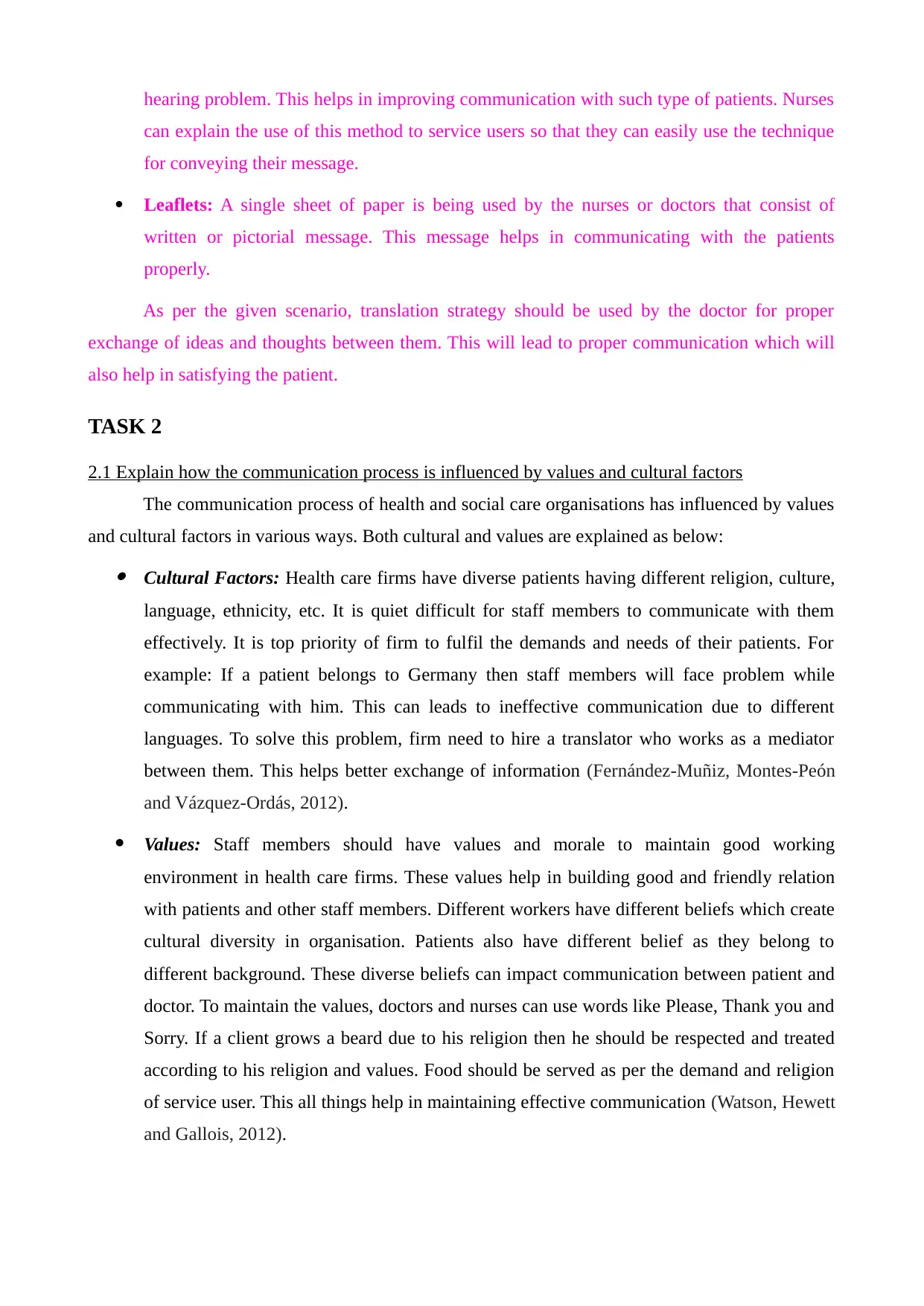
hearing problem. This helps in improving communication with such type of patients. Nurses
can explain the use of this method to service users so that they can easily use the technique
for conveying their message.
Leaflets: A single sheet of paper is being used by the nurses or doctors that consist of
written or pictorial message. This message helps in communicating with the patients
properly.
As per the given scenario, translation strategy should be used by the doctor for proper
exchange of ideas and thoughts between them. This will lead to proper communication which will
also help in satisfying the patient.
TASK 2
2.1 Explain how the communication process is influenced by values and cultural factors
The communication process of health and social care organisations has influenced by values
and cultural factors in various ways. Both cultural and values are explained as below:
Cultural Factors: Health care firms have diverse patients having different religion, culture,
language, ethnicity, etc. It is quiet difficult for staff members to communicate with them
effectively. It is top priority of firm to fulfil the demands and needs of their patients. For
example: If a patient belongs to Germany then staff members will face problem while
communicating with him. This can leads to ineffective communication due to different
languages. To solve this problem, firm need to hire a translator who works as a mediator
between them. This helps better exchange of information (Fernández-Muñiz, Montes-Peón
and Vázquez-Ordás, 2012).
Values: Staff members should have values and morale to maintain good working
environment in health care firms. These values help in building good and friendly relation
with patients and other staff members. Different workers have different beliefs which create
cultural diversity in organisation. Patients also have different belief as they belong to
different background. These diverse beliefs can impact communication between patient and
doctor. To maintain the values, doctors and nurses can use words like Please, Thank you and
Sorry. If a client grows a beard due to his religion then he should be respected and treated
according to his religion and values. Food should be served as per the demand and religion
of service user. This all things help in maintaining effective communication (Watson, Hewett
and Gallois, 2012).
can explain the use of this method to service users so that they can easily use the technique
for conveying their message.
Leaflets: A single sheet of paper is being used by the nurses or doctors that consist of
written or pictorial message. This message helps in communicating with the patients
properly.
As per the given scenario, translation strategy should be used by the doctor for proper
exchange of ideas and thoughts between them. This will lead to proper communication which will
also help in satisfying the patient.
TASK 2
2.1 Explain how the communication process is influenced by values and cultural factors
The communication process of health and social care organisations has influenced by values
and cultural factors in various ways. Both cultural and values are explained as below:
Cultural Factors: Health care firms have diverse patients having different religion, culture,
language, ethnicity, etc. It is quiet difficult for staff members to communicate with them
effectively. It is top priority of firm to fulfil the demands and needs of their patients. For
example: If a patient belongs to Germany then staff members will face problem while
communicating with him. This can leads to ineffective communication due to different
languages. To solve this problem, firm need to hire a translator who works as a mediator
between them. This helps better exchange of information (Fernández-Muñiz, Montes-Peón
and Vázquez-Ordás, 2012).
Values: Staff members should have values and morale to maintain good working
environment in health care firms. These values help in building good and friendly relation
with patients and other staff members. Different workers have different beliefs which create
cultural diversity in organisation. Patients also have different belief as they belong to
different background. These diverse beliefs can impact communication between patient and
doctor. To maintain the values, doctors and nurses can use words like Please, Thank you and
Sorry. If a client grows a beard due to his religion then he should be respected and treated
according to his religion and values. Food should be served as per the demand and religion
of service user. This all things help in maintaining effective communication (Watson, Hewett
and Gallois, 2012).
Paraphrase This Document
Need a fresh take? Get an instant paraphrase of this document with our AI Paraphraser
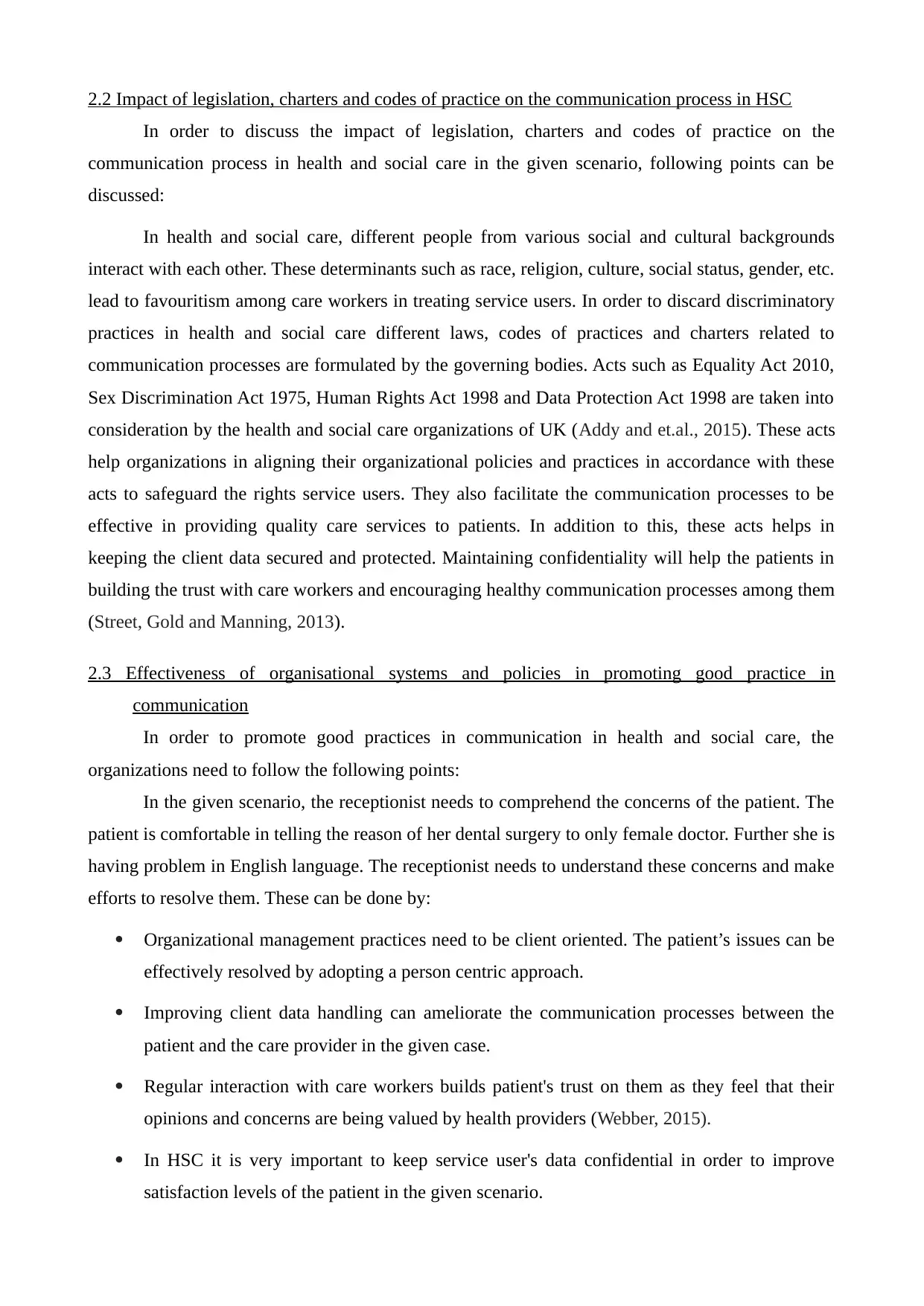
2.2 Impact of legislation, charters and codes of practice on the communication process in HSC
In order to discuss the impact of legislation, charters and codes of practice on the
communication process in health and social care in the given scenario, following points can be
discussed:
In health and social care, different people from various social and cultural backgrounds
interact with each other. These determinants such as race, religion, culture, social status, gender, etc.
lead to favouritism among care workers in treating service users. In order to discard discriminatory
practices in health and social care different laws, codes of practices and charters related to
communication processes are formulated by the governing bodies. Acts such as Equality Act 2010,
Sex Discrimination Act 1975, Human Rights Act 1998 and Data Protection Act 1998 are taken into
consideration by the health and social care organizations of UK (Addy and et.al., 2015). These acts
help organizations in aligning their organizational policies and practices in accordance with these
acts to safeguard the rights service users. They also facilitate the communication processes to be
effective in providing quality care services to patients. In addition to this, these acts helps in
keeping the client data secured and protected. Maintaining confidentiality will help the patients in
building the trust with care workers and encouraging healthy communication processes among them
(Street, Gold and Manning, 2013).
2.3 Effectiveness of organisational systems and policies in promoting good practice in
communication
In order to promote good practices in communication in health and social care, the
organizations need to follow the following points:
In the given scenario, the receptionist needs to comprehend the concerns of the patient. The
patient is comfortable in telling the reason of her dental surgery to only female doctor. Further she is
having problem in English language. The receptionist needs to understand these concerns and make
efforts to resolve them. These can be done by:
Organizational management practices need to be client oriented. The patient’s issues can be
effectively resolved by adopting a person centric approach.
Improving client data handling can ameliorate the communication processes between the
patient and the care provider in the given case.
Regular interaction with care workers builds patient's trust on them as they feel that their
opinions and concerns are being valued by health providers (Webber, 2015).
In HSC it is very important to keep service user's data confidential in order to improve
satisfaction levels of the patient in the given scenario.
In order to discuss the impact of legislation, charters and codes of practice on the
communication process in health and social care in the given scenario, following points can be
discussed:
In health and social care, different people from various social and cultural backgrounds
interact with each other. These determinants such as race, religion, culture, social status, gender, etc.
lead to favouritism among care workers in treating service users. In order to discard discriminatory
practices in health and social care different laws, codes of practices and charters related to
communication processes are formulated by the governing bodies. Acts such as Equality Act 2010,
Sex Discrimination Act 1975, Human Rights Act 1998 and Data Protection Act 1998 are taken into
consideration by the health and social care organizations of UK (Addy and et.al., 2015). These acts
help organizations in aligning their organizational policies and practices in accordance with these
acts to safeguard the rights service users. They also facilitate the communication processes to be
effective in providing quality care services to patients. In addition to this, these acts helps in
keeping the client data secured and protected. Maintaining confidentiality will help the patients in
building the trust with care workers and encouraging healthy communication processes among them
(Street, Gold and Manning, 2013).
2.3 Effectiveness of organisational systems and policies in promoting good practice in
communication
In order to promote good practices in communication in health and social care, the
organizations need to follow the following points:
In the given scenario, the receptionist needs to comprehend the concerns of the patient. The
patient is comfortable in telling the reason of her dental surgery to only female doctor. Further she is
having problem in English language. The receptionist needs to understand these concerns and make
efforts to resolve them. These can be done by:
Organizational management practices need to be client oriented. The patient’s issues can be
effectively resolved by adopting a person centric approach.
Improving client data handling can ameliorate the communication processes between the
patient and the care provider in the given case.
Regular interaction with care workers builds patient's trust on them as they feel that their
opinions and concerns are being valued by health providers (Webber, 2015).
In HSC it is very important to keep service user's data confidential in order to improve
satisfaction levels of the patient in the given scenario.
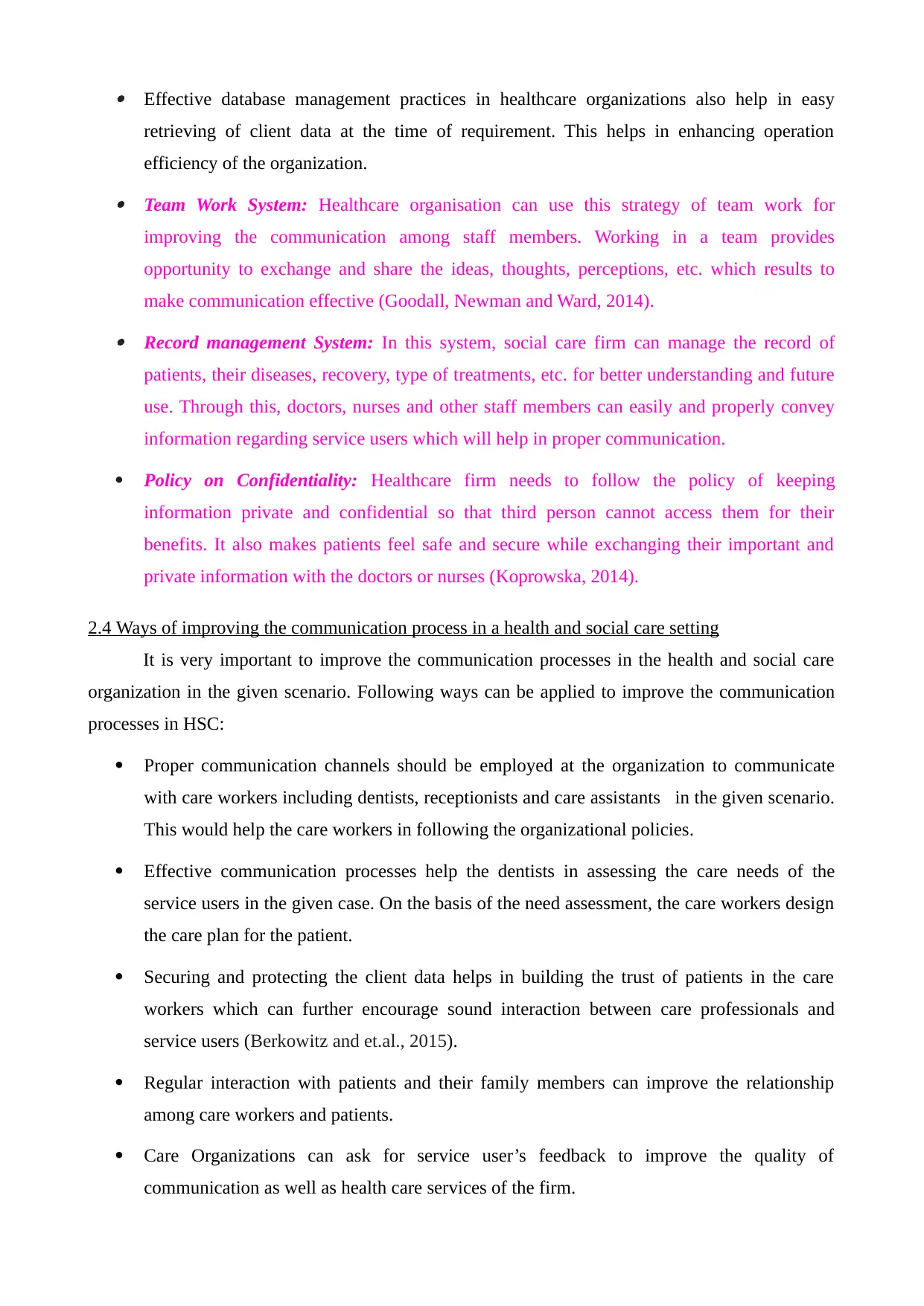
Effective database management practices in healthcare organizations also help in easy
retrieving of client data at the time of requirement. This helps in enhancing operation
efficiency of the organization.
Team Work System: Healthcare organisation can use this strategy of team work for
improving the communication among staff members. Working in a team provides
opportunity to exchange and share the ideas, thoughts, perceptions, etc. which results to
make communication effective (Goodall, Newman and Ward, 2014).
Record management System: In this system, social care firm can manage the record of
patients, their diseases, recovery, type of treatments, etc. for better understanding and future
use. Through this, doctors, nurses and other staff members can easily and properly convey
information regarding service users which will help in proper communication.
Policy on Confidentiality: Healthcare firm needs to follow the policy of keeping
information private and confidential so that third person cannot access them for their
benefits. It also makes patients feel safe and secure while exchanging their important and
private information with the doctors or nurses (Koprowska, 2014).
2.4 Ways of improving the communication process in a health and social care setting
It is very important to improve the communication processes in the health and social care
organization in the given scenario. Following ways can be applied to improve the communication
processes in HSC:
Proper communication channels should be employed at the organization to communicate
with care workers including dentists, receptionists and care assistants in the given scenario.
This would help the care workers in following the organizational policies.
Effective communication processes help the dentists in assessing the care needs of the
service users in the given case. On the basis of the need assessment, the care workers design
the care plan for the patient.
Securing and protecting the client data helps in building the trust of patients in the care
workers which can further encourage sound interaction between care professionals and
service users (Berkowitz and et.al., 2015).
Regular interaction with patients and their family members can improve the relationship
among care workers and patients.
Care Organizations can ask for service user’s feedback to improve the quality of
communication as well as health care services of the firm.
retrieving of client data at the time of requirement. This helps in enhancing operation
efficiency of the organization.
Team Work System: Healthcare organisation can use this strategy of team work for
improving the communication among staff members. Working in a team provides
opportunity to exchange and share the ideas, thoughts, perceptions, etc. which results to
make communication effective (Goodall, Newman and Ward, 2014).
Record management System: In this system, social care firm can manage the record of
patients, their diseases, recovery, type of treatments, etc. for better understanding and future
use. Through this, doctors, nurses and other staff members can easily and properly convey
information regarding service users which will help in proper communication.
Policy on Confidentiality: Healthcare firm needs to follow the policy of keeping
information private and confidential so that third person cannot access them for their
benefits. It also makes patients feel safe and secure while exchanging their important and
private information with the doctors or nurses (Koprowska, 2014).
2.4 Ways of improving the communication process in a health and social care setting
It is very important to improve the communication processes in the health and social care
organization in the given scenario. Following ways can be applied to improve the communication
processes in HSC:
Proper communication channels should be employed at the organization to communicate
with care workers including dentists, receptionists and care assistants in the given scenario.
This would help the care workers in following the organizational policies.
Effective communication processes help the dentists in assessing the care needs of the
service users in the given case. On the basis of the need assessment, the care workers design
the care plan for the patient.
Securing and protecting the client data helps in building the trust of patients in the care
workers which can further encourage sound interaction between care professionals and
service users (Berkowitz and et.al., 2015).
Regular interaction with patients and their family members can improve the relationship
among care workers and patients.
Care Organizations can ask for service user’s feedback to improve the quality of
communication as well as health care services of the firm.
⊘ This is a preview!⊘
Do you want full access?
Subscribe today to unlock all pages.

Trusted by 1+ million students worldwide
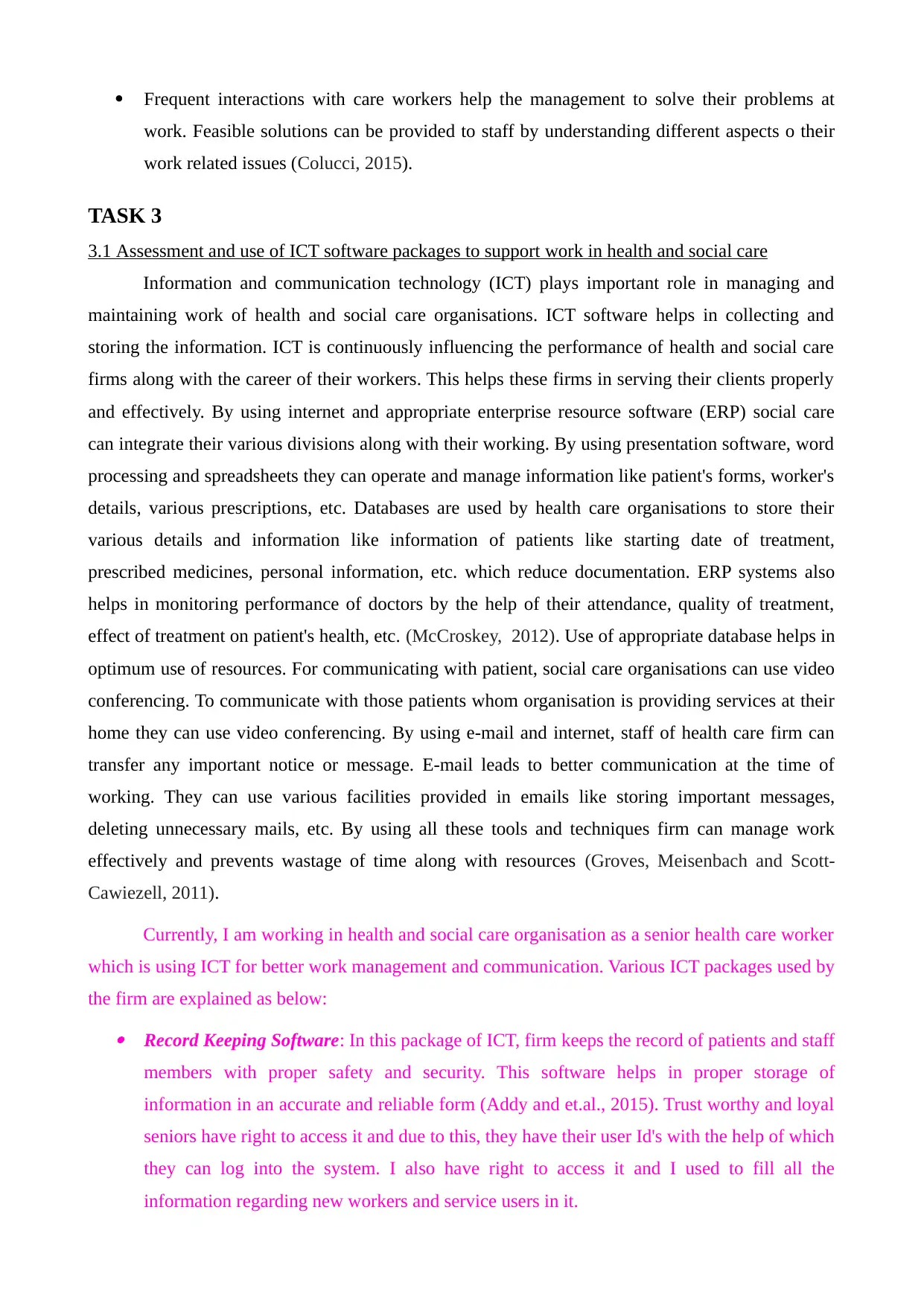
Frequent interactions with care workers help the management to solve their problems at
work. Feasible solutions can be provided to staff by understanding different aspects o their
work related issues (Colucci, 2015).
TASK 3
3.1 Assessment and use of ICT software packages to support work in health and social care
Information and communication technology (ICT) plays important role in managing and
maintaining work of health and social care organisations. ICT software helps in collecting and
storing the information. ICT is continuously influencing the performance of health and social care
firms along with the career of their workers. This helps these firms in serving their clients properly
and effectively. By using internet and appropriate enterprise resource software (ERP) social care
can integrate their various divisions along with their working. By using presentation software, word
processing and spreadsheets they can operate and manage information like patient's forms, worker's
details, various prescriptions, etc. Databases are used by health care organisations to store their
various details and information like information of patients like starting date of treatment,
prescribed medicines, personal information, etc. which reduce documentation. ERP systems also
helps in monitoring performance of doctors by the help of their attendance, quality of treatment,
effect of treatment on patient's health, etc. (McCroskey, 2012). Use of appropriate database helps in
optimum use of resources. For communicating with patient, social care organisations can use video
conferencing. To communicate with those patients whom organisation is providing services at their
home they can use video conferencing. By using e-mail and internet, staff of health care firm can
transfer any important notice or message. E-mail leads to better communication at the time of
working. They can use various facilities provided in emails like storing important messages,
deleting unnecessary mails, etc. By using all these tools and techniques firm can manage work
effectively and prevents wastage of time along with resources (Groves, Meisenbach and Scott‐
Cawiezell, 2011).
Currently, I am working in health and social care organisation as a senior health care worker
which is using ICT for better work management and communication. Various ICT packages used by
the firm are explained as below:
Record Keeping Software: In this package of ICT, firm keeps the record of patients and staff
members with proper safety and security. This software helps in proper storage of
information in an accurate and reliable form (Addy and et.al., 2015). Trust worthy and loyal
seniors have right to access it and due to this, they have their user Id's with the help of which
they can log into the system. I also have right to access it and I used to fill all the
information regarding new workers and service users in it.
work. Feasible solutions can be provided to staff by understanding different aspects o their
work related issues (Colucci, 2015).
TASK 3
3.1 Assessment and use of ICT software packages to support work in health and social care
Information and communication technology (ICT) plays important role in managing and
maintaining work of health and social care organisations. ICT software helps in collecting and
storing the information. ICT is continuously influencing the performance of health and social care
firms along with the career of their workers. This helps these firms in serving their clients properly
and effectively. By using internet and appropriate enterprise resource software (ERP) social care
can integrate their various divisions along with their working. By using presentation software, word
processing and spreadsheets they can operate and manage information like patient's forms, worker's
details, various prescriptions, etc. Databases are used by health care organisations to store their
various details and information like information of patients like starting date of treatment,
prescribed medicines, personal information, etc. which reduce documentation. ERP systems also
helps in monitoring performance of doctors by the help of their attendance, quality of treatment,
effect of treatment on patient's health, etc. (McCroskey, 2012). Use of appropriate database helps in
optimum use of resources. For communicating with patient, social care organisations can use video
conferencing. To communicate with those patients whom organisation is providing services at their
home they can use video conferencing. By using e-mail and internet, staff of health care firm can
transfer any important notice or message. E-mail leads to better communication at the time of
working. They can use various facilities provided in emails like storing important messages,
deleting unnecessary mails, etc. By using all these tools and techniques firm can manage work
effectively and prevents wastage of time along with resources (Groves, Meisenbach and Scott‐
Cawiezell, 2011).
Currently, I am working in health and social care organisation as a senior health care worker
which is using ICT for better work management and communication. Various ICT packages used by
the firm are explained as below:
Record Keeping Software: In this package of ICT, firm keeps the record of patients and staff
members with proper safety and security. This software helps in proper storage of
information in an accurate and reliable form (Addy and et.al., 2015). Trust worthy and loyal
seniors have right to access it and due to this, they have their user Id's with the help of which
they can log into the system. I also have right to access it and I used to fill all the
information regarding new workers and service users in it.
Paraphrase This Document
Need a fresh take? Get an instant paraphrase of this document with our AI Paraphraser
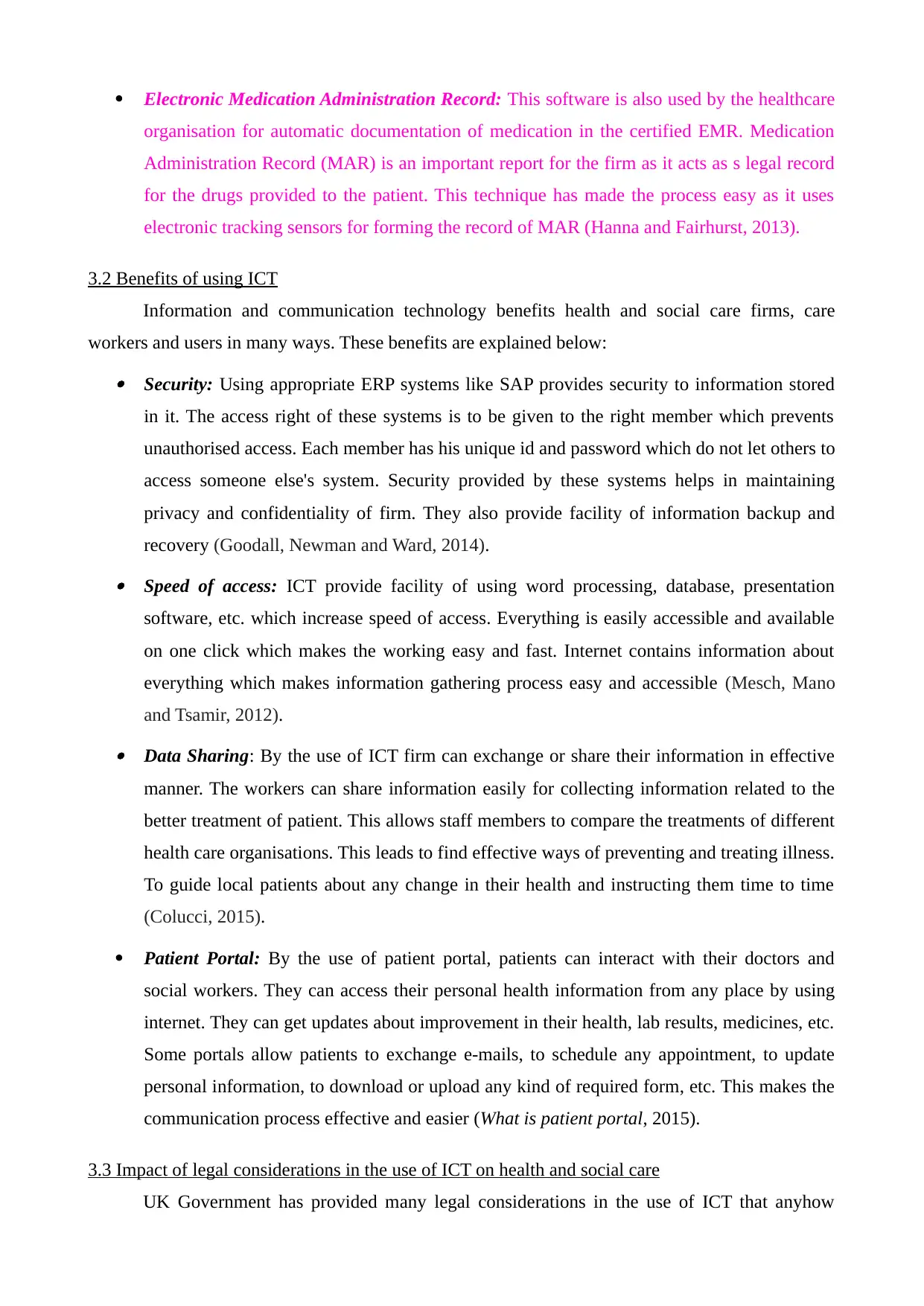
Electronic Medication Administration Record: This software is also used by the healthcare
organisation for automatic documentation of medication in the certified EMR. Medication
Administration Record (MAR) is an important report for the firm as it acts as s legal record
for the drugs provided to the patient. This technique has made the process easy as it uses
electronic tracking sensors for forming the record of MAR (Hanna and Fairhurst, 2013).
3.2 Benefits of using ICT
Information and communication technology benefits health and social care firms, care
workers and users in many ways. These benefits are explained below:
Security: Using appropriate ERP systems like SAP provides security to information stored
in it. The access right of these systems is to be given to the right member which prevents
unauthorised access. Each member has his unique id and password which do not let others to
access someone else's system. Security provided by these systems helps in maintaining
privacy and confidentiality of firm. They also provide facility of information backup and
recovery (Goodall, Newman and Ward, 2014).
Speed of access: ICT provide facility of using word processing, database, presentation
software, etc. which increase speed of access. Everything is easily accessible and available
on one click which makes the working easy and fast. Internet contains information about
everything which makes information gathering process easy and accessible (Mesch, Mano
and Tsamir, 2012).
Data Sharing: By the use of ICT firm can exchange or share their information in effective
manner. The workers can share information easily for collecting information related to the
better treatment of patient. This allows staff members to compare the treatments of different
health care organisations. This leads to find effective ways of preventing and treating illness.
To guide local patients about any change in their health and instructing them time to time
(Colucci, 2015).
Patient Portal: By the use of patient portal, patients can interact with their doctors and
social workers. They can access their personal health information from any place by using
internet. They can get updates about improvement in their health, lab results, medicines, etc.
Some portals allow patients to exchange e-mails, to schedule any appointment, to update
personal information, to download or upload any kind of required form, etc. This makes the
communication process effective and easier (What is patient portal, 2015).
3.3 Impact of legal considerations in the use of ICT on health and social care
UK Government has provided many legal considerations in the use of ICT that anyhow
organisation for automatic documentation of medication in the certified EMR. Medication
Administration Record (MAR) is an important report for the firm as it acts as s legal record
for the drugs provided to the patient. This technique has made the process easy as it uses
electronic tracking sensors for forming the record of MAR (Hanna and Fairhurst, 2013).
3.2 Benefits of using ICT
Information and communication technology benefits health and social care firms, care
workers and users in many ways. These benefits are explained below:
Security: Using appropriate ERP systems like SAP provides security to information stored
in it. The access right of these systems is to be given to the right member which prevents
unauthorised access. Each member has his unique id and password which do not let others to
access someone else's system. Security provided by these systems helps in maintaining
privacy and confidentiality of firm. They also provide facility of information backup and
recovery (Goodall, Newman and Ward, 2014).
Speed of access: ICT provide facility of using word processing, database, presentation
software, etc. which increase speed of access. Everything is easily accessible and available
on one click which makes the working easy and fast. Internet contains information about
everything which makes information gathering process easy and accessible (Mesch, Mano
and Tsamir, 2012).
Data Sharing: By the use of ICT firm can exchange or share their information in effective
manner. The workers can share information easily for collecting information related to the
better treatment of patient. This allows staff members to compare the treatments of different
health care organisations. This leads to find effective ways of preventing and treating illness.
To guide local patients about any change in their health and instructing them time to time
(Colucci, 2015).
Patient Portal: By the use of patient portal, patients can interact with their doctors and
social workers. They can access their personal health information from any place by using
internet. They can get updates about improvement in their health, lab results, medicines, etc.
Some portals allow patients to exchange e-mails, to schedule any appointment, to update
personal information, to download or upload any kind of required form, etc. This makes the
communication process effective and easier (What is patient portal, 2015).
3.3 Impact of legal considerations in the use of ICT on health and social care
UK Government has provided many legal considerations in the use of ICT that anyhow
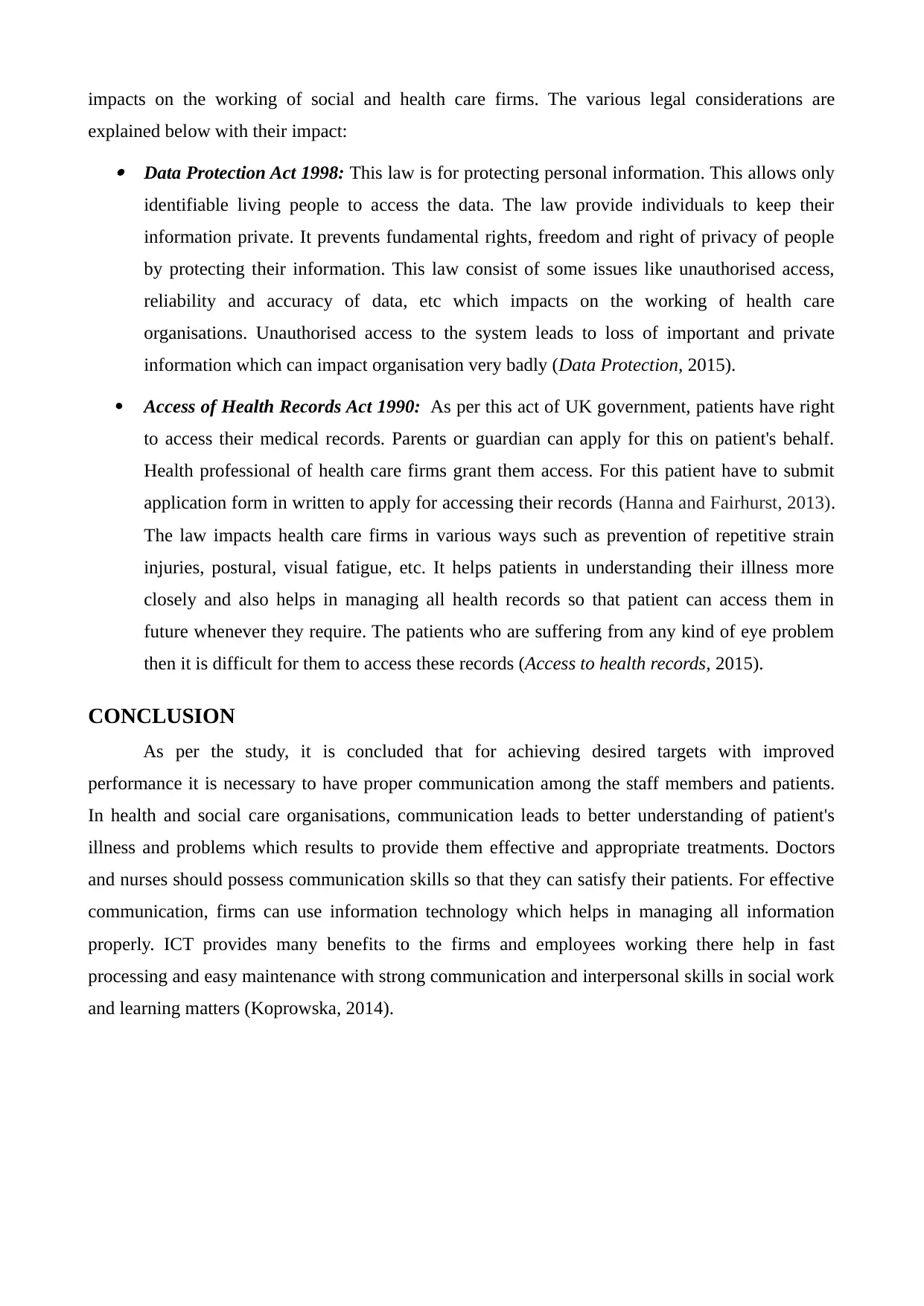
impacts on the working of social and health care firms. The various legal considerations are
explained below with their impact:
Data Protection Act 1998: This law is for protecting personal information. This allows only
identifiable living people to access the data. The law provide individuals to keep their
information private. It prevents fundamental rights, freedom and right of privacy of people
by protecting their information. This law consist of some issues like unauthorised access,
reliability and accuracy of data, etc which impacts on the working of health care
organisations. Unauthorised access to the system leads to loss of important and private
information which can impact organisation very badly (Data Protection, 2015).
Access of Health Records Act 1990: As per this act of UK government, patients have right
to access their medical records. Parents or guardian can apply for this on patient's behalf.
Health professional of health care firms grant them access. For this patient have to submit
application form in written to apply for accessing their records (Hanna and Fairhurst, 2013).
The law impacts health care firms in various ways such as prevention of repetitive strain
injuries, postural, visual fatigue, etc. It helps patients in understanding their illness more
closely and also helps in managing all health records so that patient can access them in
future whenever they require. The patients who are suffering from any kind of eye problem
then it is difficult for them to access these records (Access to health records, 2015).
CONCLUSION
As per the study, it is concluded that for achieving desired targets with improved
performance it is necessary to have proper communication among the staff members and patients.
In health and social care organisations, communication leads to better understanding of patient's
illness and problems which results to provide them effective and appropriate treatments. Doctors
and nurses should possess communication skills so that they can satisfy their patients. For effective
communication, firms can use information technology which helps in managing all information
properly. ICT provides many benefits to the firms and employees working there help in fast
processing and easy maintenance with strong communication and interpersonal skills in social work
and learning matters (Koprowska, 2014).
explained below with their impact:
Data Protection Act 1998: This law is for protecting personal information. This allows only
identifiable living people to access the data. The law provide individuals to keep their
information private. It prevents fundamental rights, freedom and right of privacy of people
by protecting their information. This law consist of some issues like unauthorised access,
reliability and accuracy of data, etc which impacts on the working of health care
organisations. Unauthorised access to the system leads to loss of important and private
information which can impact organisation very badly (Data Protection, 2015).
Access of Health Records Act 1990: As per this act of UK government, patients have right
to access their medical records. Parents or guardian can apply for this on patient's behalf.
Health professional of health care firms grant them access. For this patient have to submit
application form in written to apply for accessing their records (Hanna and Fairhurst, 2013).
The law impacts health care firms in various ways such as prevention of repetitive strain
injuries, postural, visual fatigue, etc. It helps patients in understanding their illness more
closely and also helps in managing all health records so that patient can access them in
future whenever they require. The patients who are suffering from any kind of eye problem
then it is difficult for them to access these records (Access to health records, 2015).
CONCLUSION
As per the study, it is concluded that for achieving desired targets with improved
performance it is necessary to have proper communication among the staff members and patients.
In health and social care organisations, communication leads to better understanding of patient's
illness and problems which results to provide them effective and appropriate treatments. Doctors
and nurses should possess communication skills so that they can satisfy their patients. For effective
communication, firms can use information technology which helps in managing all information
properly. ICT provides many benefits to the firms and employees working there help in fast
processing and easy maintenance with strong communication and interpersonal skills in social work
and learning matters (Koprowska, 2014).
⊘ This is a preview!⊘
Do you want full access?
Subscribe today to unlock all pages.

Trusted by 1+ million students worldwide
1 out of 14
Related Documents
Your All-in-One AI-Powered Toolkit for Academic Success.
+13062052269
info@desklib.com
Available 24*7 on WhatsApp / Email
![[object Object]](/_next/static/media/star-bottom.7253800d.svg)
Unlock your academic potential
Copyright © 2020–2025 A2Z Services. All Rights Reserved. Developed and managed by ZUCOL.





